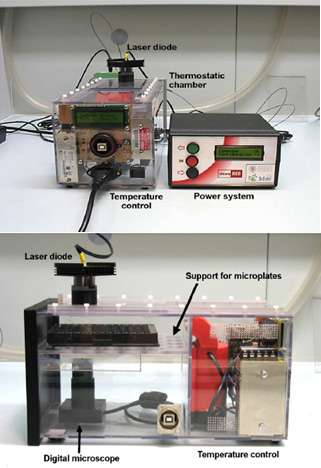Researchers develop a lab-scale prototype for the treatment of skin tumors

Researchers from Universidad Politécnica de Madrid, in collaboration with Universitat Politécnica de Valencia and CIBER's Bioengineering, Biomaterials and Nanomedicine (CIBER-BBN), have designed a laser device specifically designed for optical hyperthermia applications.
A joint research project of Universidad Politécnica de Madrid (UPM), Universitat Politécnica de Valencia (UPV) and CIBER's Bioengineering, Biomaterials and Nanomedicine (CIBER-BBN) has developed a low-cost, lab-scale device for treatments based on optical hyperthermia applications via laser. This technique is used in therapies against skin cancer, and it kills the tumor cells by overheating them. This research has been published in Sensors and Actuators A Physical.
According to the researchers, overheating is achieved by irradiating synthesized metallic nanoparticles. "When receiving radiation, the particles heat the tumor tissue, reaching a temperature between 42 °C and 48 °C, causing hypoxia that leads to cellular death," explains Roberto Montes, a researcher from UPV.
The prototype developed by both UPM and UPV researchers consists of an infrared laser with a power up to 500mW able to provide a power density up to 4W/cm2, a sensor that records the temperature in real time during the irradiation, and a laser power regulator, among other components.
However, if the laser is focused on tissues impregnated with gold nanoparticles (Au-NPs), it causes local overheating. This presents a great advantage compared to other techniques that cannot distinguish between healthy tissues and damaged tissues," says Roberto Montes.
According to the researchers, there are diverse laser applicators on the market used in dermatology and even surgery. At certain power and wavelengths, the laser energy is converted into heat and produces ablation (burning). The new system does not aim to "burn" the cells with the adjacent inflammation that this causes, but to introduce nanoheaters into such cells, which, when excited by the laser, increase in temperature between 42 °C and 48 °C, resulting in hypoxia and the cells' "natural" death.
This equipment is already being successfully used in vitro cellular crops and in therapies that combine hyperthermia with the controlled release of drugs. "Although the equipment has been designed to exclusively work in a lab environment, once the technique is refined, it could be easily applied to a hospital environment with small changes. Of course, we are in an initial phase, and there is much to do toward clinical usage: animal tissue testing, later testing on living animals, and finally to verify its application in patients", add Javier Ibáñez.
Provided by Universidad Politécnica de Madrid




















